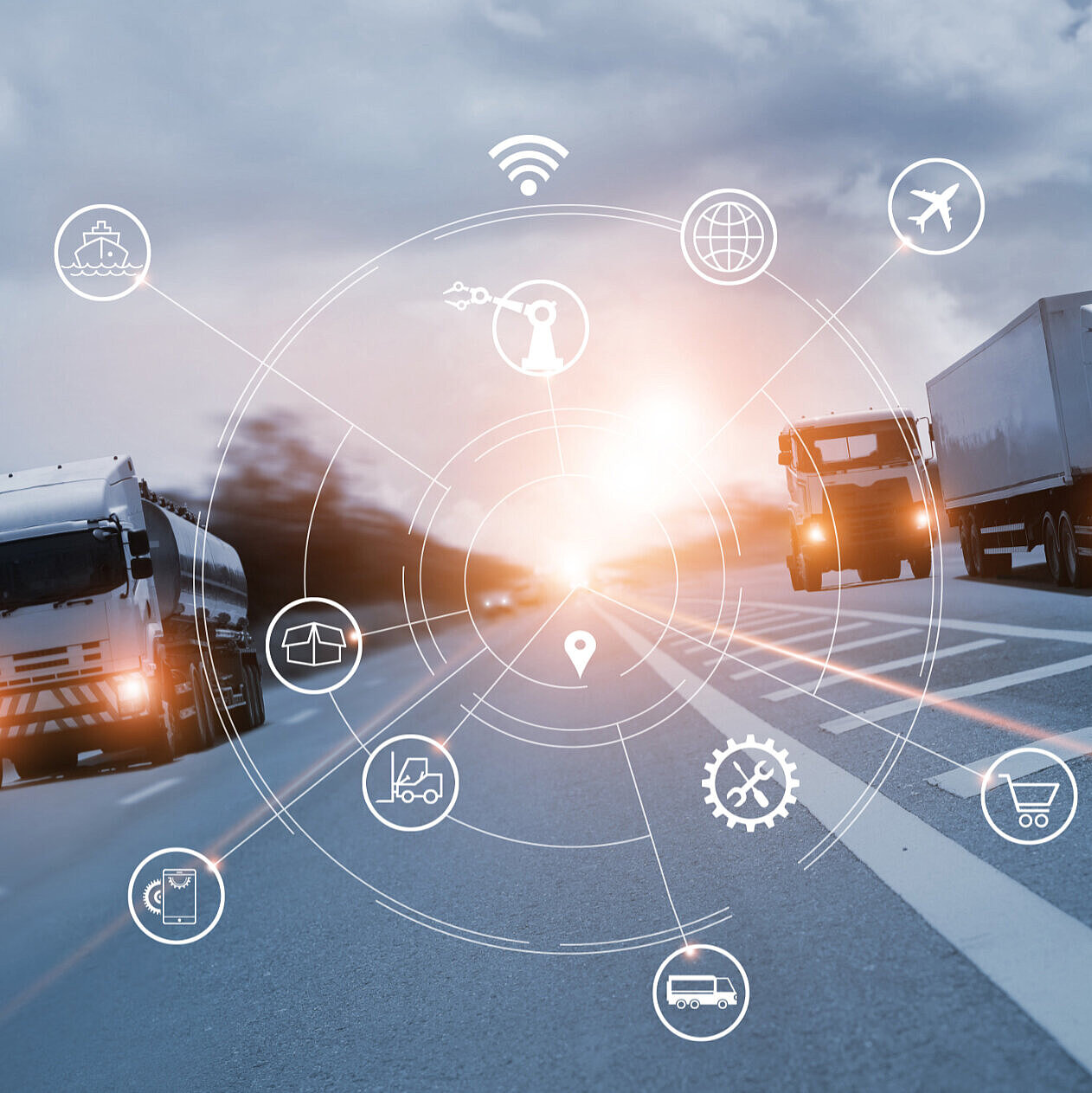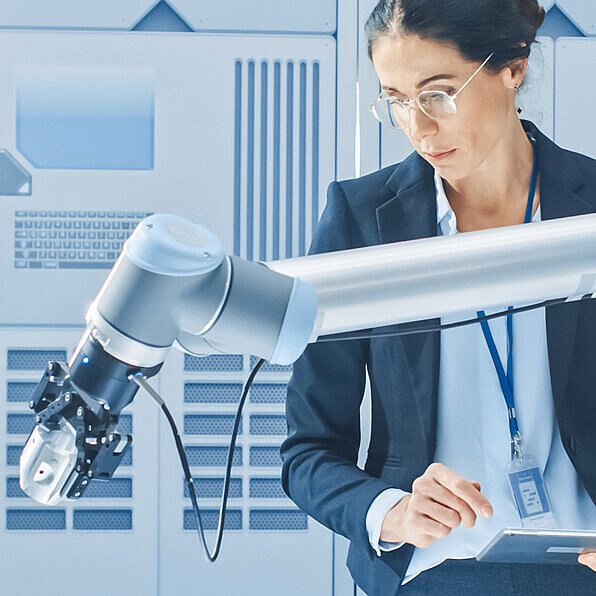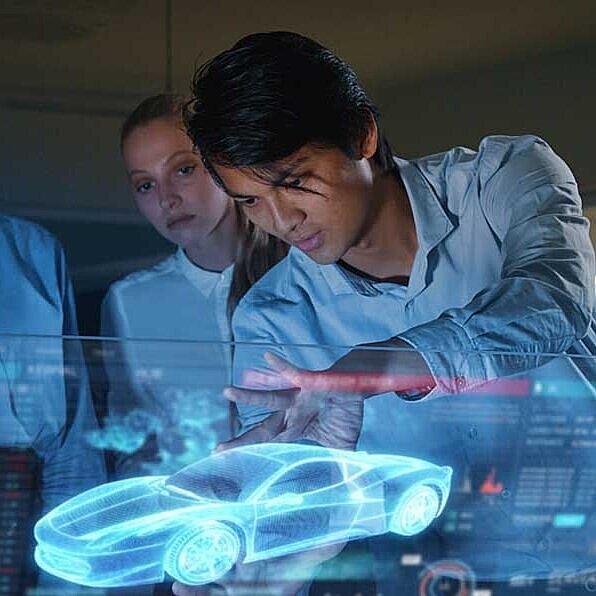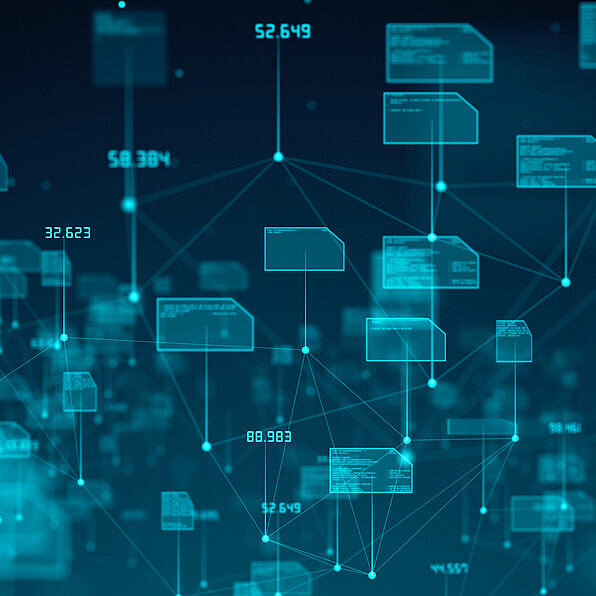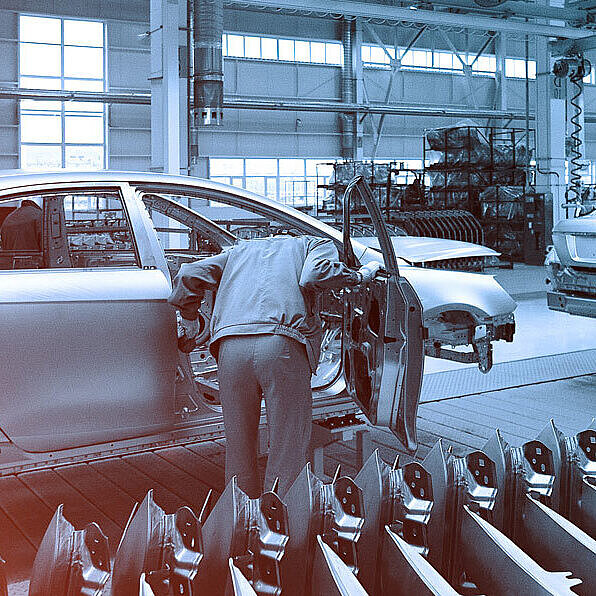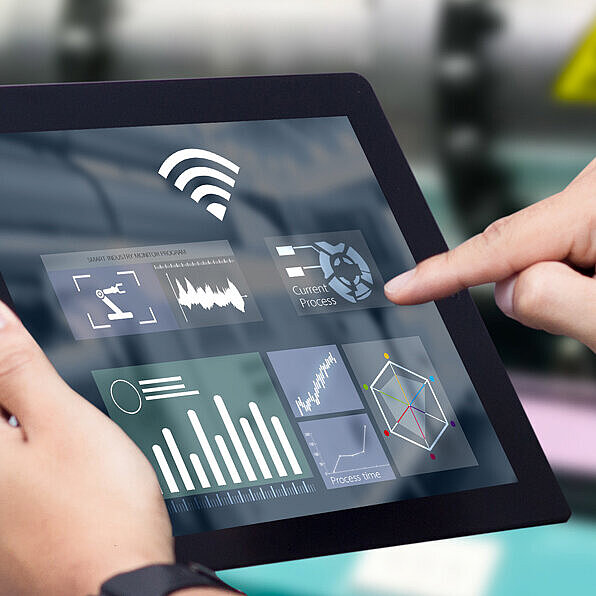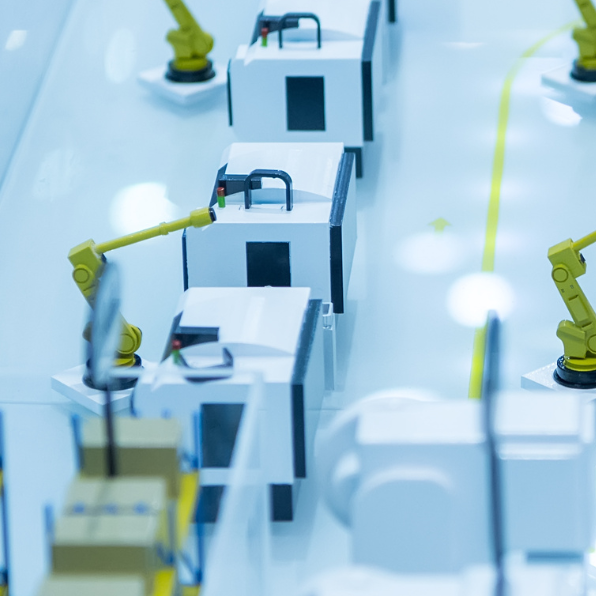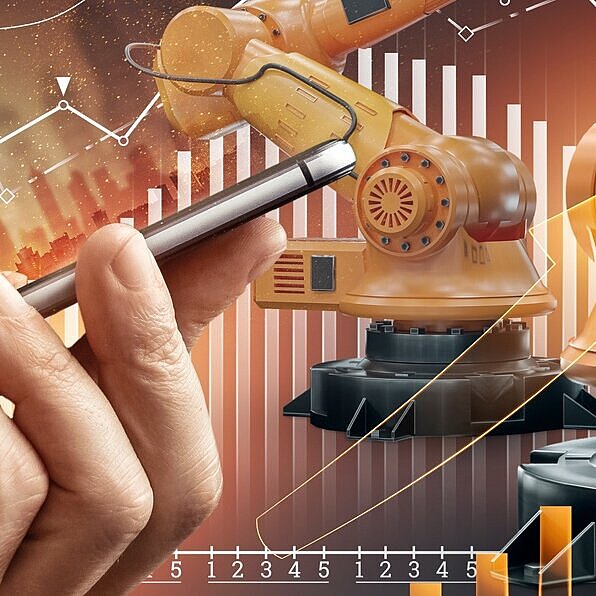Webinar series of the Mechatronics & Automation Cluster
A bridge between science and industry - from research to practice
The Mechatronics & Automation Cluster acts as a bridge between science and industry to support the transfer of knowledge from scientific findings to industrial companies, to facilitate access to research institutions and to transfer requirements from industry to science. With the webinar series "From research to practice", we would like to make a contribution to this.

Presentations and discussion
As part of the series, we address a current topic from the field of digital production and digital engineering every two months and offer exciting insights into current research activities and their application in industrial practice. The individual dates of the webinar series comprise two or three presentations and a Q&A session or final discussion with all speakers.
Target group
Companies and firms that are interested in current and future development results as well as research institutions that want to transfer their research results into practice and receive impulses from industry.
The focus is particularly on
- Manufacturing companies (especially SMEs), even if there have been no or only a few collaborations with research institutes to date.
- Machine manufacturers (especially SMEs)
- University and non-university research institutions
Procedure of the individual appointments
- Duration: 90 minutes
- Implementation via Teams Webinar
- Dates take place every 2 months, each Thursday from 13:00 to 14:30.
- Participation in the event is free of charge.
Current dates of the webinar series
Discover with us the latest developments in robotics for the industrial production of the future!
Together with the German Aerospace Center (DLR), we will provide you with exciting insights into current research trends, technological innovations and practical applications in the field of robotics in our webinar.
Past dates
Intelligent supply chain risk management (especially for SMEs)
Prof. Dr. Michael Krupp
Professorship of General Business Administration with a focus on Logistics and Supply Chain Management | Augsburg University of Applied Sciences
Data analysis and data visualization in SCRM via dashboards
Kai Uwe Stahl
Managing Director "BI or DIE"
Experience report on uncertain times from the perspective of a company
Dr. Daniel Siedl
Founder & CEO, OPERATIONS FACTORY e.U.
Decisions under uncertainty from the perspective of business psychology - current state of science
Prof. Dr. Simone Kubowitsch
Augsburg University of Applied Sciences
Entrepreneurial implementation of AI-supported decision support systems
Prof. Dr. Sarah Hatfield
Augsburg University of Applied Sciences
5G and other communication systems - state of the art
Burkhardt Frank
Group Manager, Fraunhofer IIS
Karin Loidl
Technology Advisor, Fraunhofer IIS
User quality in Industry 4.0 applications in campus networks - insights into an ongoing ICT project
Dr. David Hock
Director of Research, Infosim
Robert Fröhler
Campus Network Sales Manager for Austria, Nokia
Usability - increasing the quality of work in production with curiosity
David Blank
Research Associate, Interaction Design and Technologies Team, Fraunhofer Institute for Industrial Engineering IAO
Everyone has heard of usability, user experience and design. Why are these topics still so important for industry, what has changed and how can a lot be achieved independently in the production context using simple means? We take a look behind the scenes of current research projects that we are conducting together with industry partners.
Standardized product world - A case study on the app world of Trumpf
Franz Koller
Director Sales & Business Development | UID GmbH
UX in robotics
Jessica Rademacher
Head Of Product UX | KUKA Deutschland GmbH
OPC UA, AAS and AML - an overview of their joint potentials
Maximilian Wagner
VDMA e.V.
Making Industry 4.0 simple - Eclipse BaSyx as an enabler
Rene-Pascal Fischer
Scientist, Dept. Virtual Engineering, Fraunhofer Institute for Experimental Software Engineering IESE
This talk will focus on the open source middleware Eclipse BaSyx and its important role in the creation of digital twins based on the asset administration shell standard. In addition to a software development kit in various programming languages, Eclipse BaSyx also offers "off-the-shelf" components that enable easy integration into existing systems and at the same time offer a low barrier to entry. These open concepts make it easier to connect data from sensors, (I)IoT devices and other sources in order to create a digital representation of all relevant assets and make them available via standardized interfaces.
How do I track the carbon footprint of my products? The administration shell for mapping the entire production process
Christof Baumgartner
XITASO GmbH IT & Software Solutions
Human-robot collaboration in industrial assembly and disassembly
Prof. Dr. Tobias Kaupp
Professor for Digital Production & Robotics and Head of the Center for Robotics (CERI), Würzburg-Schweinfurt University of Applied Sciences (THWS)
The lecture will report on two current research activities of the Center for Robotics (CERI) at the Würzburg-Schweinfurt University of Applied Sciences (THWS) in the field of human-robot collaboration (HRC):
- Collaborative process chain for the assembly of components: from planning to product
- Disassembly of components using the example of e-waste
Intuitive configuration and flexible execution on variable robot stations
Dr.-Ing. Korbinian Nottensteiner
Project manager and spokesperson for the Production of the Future domain of the Institute of Robotics and Mechatronics, German Aerospace Center (DLR), Oberpfaffenhofen
The presentation will begin with a brief overview of the research work of the German Aerospace Center (DLR) from the "Factory of the Future Extended (FoF-X)" project. It will then show how variable robot workstations can be used to easily implement a wide range of production tasks, from assembly to quality assurance. The collaborative lightweight robot SARA from the DLR Institute of Robotics and Mechatronics is the central element and, together with the Human Factory Interface (HFI), enables intuitive configuration and flexible execution.
AI for industrial robots: With robobrain® to maximum flexibility in your company
Roland Singer
Partner Manager, robominds GmbH
Programming with ChatGPT: How does generative AI change the tasks in software development?
Prof. Dr. Albrecht Schmidt, Professor of Computer Science, Ludwig-Maximilians-University Munich
The costs in software development are mainly personnel costs. The big questions are: Can AI tools and especially large language models make work more efficient? How can generative AI simplify tasks in software and system development? And how will product quality change? The presentation will address these questions and discuss how these developments can affect digitalization and employees. In particular, the question arises as to what skills developers and engineers need to be able to play a meaningful role in shaping the future.
Meaningful use of AI tools in engineering - but where and how?
Amelie Tihlarik, Research Assistant, Chair of Sociology with a focus on Technology - Work - Society, Friedrich-Alexander-Universität Erlangen-Nürnberg
Particularly in technical fields such as engineering, it is often assumed that the use of AI tools is quick and easy to implement and also delivers added value for employees and work processes in a timely manner. However, it is often unclear what the reality actually looks like, what the status quo is with regard to the use of AI tools in engineering and where the first value-adding approaches to AI tools can actually be identified from the employees' point of view. It is precisely this perspective that will be examined in more detail in the presentation. Using examples from the MoSyS research project, the first concrete starting points for the implementation of AI in engineering and for the next steps will be shown.
Resource efficiency in development and production with methods and engineering AI
Peter Stirnweiß, Lead Engineer and Six Sigma Black Belt, mts Consulting & Engineering GmbH
The lecture will present practical projects in which engineering AI was successfully used to sustainably increase resource and energy efficiency and quality while also reducing development and manufacturing costs. The presentation will also provide an insight into how such projects can be approached methodically and step by step in order to digitalize processes in parallel.
Vision: 2045 - towards climate-neutral production with digitalization
Germany is to become climate-neutral by 2045. To achieve this goal, science, industry and politics are placing great expectations in the possibilities of digitalization. However, it is unclear exactly what the path to climate-neutral production with digitalization can look like for the overall system of the energy sector and industry. Against this backdrop, the ZD.B thematic platforms Digital Production & Engineering and Digitalization in the Energy Sector, together with Technology and Innovation Management at Bayern Innovativ, have developed the strategy roadmap "Vision: 2045 - towards climate-neutral production with digitalization" as part of several workshops and interviews with experts. In the three parts "Drivers and trends", "Fields of application" and "Framework conditions", the study shows what the path to climate-neutral production with digitalization could look like in 2045. Specifically, the roadmap illustrates which factors have an impact on achieving the vision, which digital applications can be used to achieve the vision and which framework conditions should be created to enable the vision to be achieved.
Manufacturing-X - The open initiative to build the cross-sector and decentralized data space for Industry 4.0
Fabian Hammel
Division IVA3 Digitalization, Industry 4.0, Federal Ministry for Economic Affairs and Climate Protection
This short presentation will introduce the Manufacturing-X industry initiative from the BMWK's perspective. The following questions will be discussed: What are the BMWK's strategic objectives in supporting the Manufacturing-X industry initiative? How does the initiative fit into the existing Industry 4.0 project landscape? And what are the planning status and possible contents of a funding program to support Manufacturing-X?
Administration shell and Eclipse Dataspace Connector (EDC), building blocks for data spaces for the implementation of Manufacturing-X
Johannes Diemer
Research Coordinator, ARENA2036 e.V.
The role of Manufacturing-X for the realization of adaptive manufacturing process chains
Norbert Skala
Head of Digitalization Operations, GRAMMER AG
There are major interdependencies between the individual process steps in a value chain. In order to achieve the best possible product quality and production efficiency, it is therefore necessary to react to information from previous process steps. How such adaptive process chains can be realized with the help of digital technologies is currently being investigated under the leadership of GRAMMER AG in the AdaProQ research project. The presentation will provide an insight into the project and show what role Manufacturing-X plays in the realization of adaptive manufacturing process chains.
Variant diversity in medium-sized manufacturing companies: causes and potential solutions
Prof. Dr.-Ing. Peter Wurster
Professor of Production Systems, Kempten University of Applied Sciences
- Increase in variant diversity as a permanent phenomenon
- Resulting loss of effectiveness and efficiency in flow production
- Potential solutions: Digital tools, moving away from fixed paths and cycles
End-to-end automation of product design, production and process flow planning
Steffen Geinitz
Senior Business Developer - Advanced Composite Solutions, Fraunhofer Institute for Casting, Composite and Processing Technology IGCV
The complexity of today's products and the associated complexity of the entire development process is placing increasingly higher demands on companies. At the same time, development cycles are becoming shorter and there are fewer skilled personnel. Using the example of the design of components for a helicopter, the development methodology of graph-based design languages and their potential for a continuous and automated development process from design to line balancing in production will be presented.
AI production network - an outlook on modular production in Augsburg
Andreas Hackner
Project Manager Technology, AI Production Network Cluster Mechatronics & Automation, Bayern Innovativ GmbH, Augsburg
The aim of the AI Production Network Augsburg with numerous research partners and business development networks from the Augsburg region is the joint research of AI-based production technologies at the interface between materials, manufacturing technologies and data-based modeling as well as the development of sustainable business models. In particular, the focus is on the further development of linear production towards flexible production.
The Metaverse - a classification
Prof. Dr. Jens Grubert
Research Professor for Human-Machine Interaction in the Internet of Things & Head of the Laboratory for Augmented and Virtual Reality, Coburg University of Applied Sciences
The term metaverse is currently associated with a variety of ideas and expectations, ranging from "gimmick" to "the future of the internet". The presentation will provide an overview of current developments in the field of the metaverse.
Research prototype "PlanAR" goes Metaverse
Maximilian Rosilius
Research assistant at the Center Intelligent Production Systems, University of Applied Sciences Würzburg-Schweinfurt (FHWS)
Steffen Decker
Software developer, Simplifier AG
The consortium of the PlanAR research project is researching and developing a platform-based solution for the usable use of industrial augmented reality (AR) applications. The aim of the project is to use mixed reality technology to make contextual information accessible to SMEs during planning, commissioning and machine use. The two research institutes of the Institute of Digital Engineering at the University of Applied Sciences Würzburg-Schweinfurt (FHWS) and the Chair of Psychology 1 at the Julius-Maximilians-Universität Würzburg are investigating not only the technical challenges but also the human impact of this technology for long-term use.
The PlanAR platform represents a prototype component on the way to an industrial metaverse. The two speakers Steffen Decker (Simplifier AG) and Maximilian Rosilius (Center Intelligent Production Systems/FHWS) will use their project experience to discuss both the maturity level and the industrial application possibilities of a future metaverse.(https://www.fhws.de/forschung/institute/idee/idee-projekte/planar/)
The industrial metaverse - buzzword or real added value?
Gerhard Kreß
Vice President Xcelerator Portfolio & Digital Business, Siemens AG
For many people, the metaverse is just a buzzword from Silicon Valley. This presentation shows that the metaverse already offers many companies great advantages, particularly in the industrial sector, and that it has what it takes to fundamentally improve the competitiveness of the manufacturing industry in Bavaria in the coming years. However, this revolution will only succeed if we in Germany tackle the issue together and drive it forward!
Digital Product Passport (DPP) interoperable - central catalyst for the digital and green transformation
Johannes Benjamin Helfritz
Project Coordinator Digital Product Passport, DIN German Institute for Standardization e.V.
The development of a circular economy requires a Digital Product Passport (DPP). At the same time, the DPP is a consequence and necessary instrument of various digitalization efforts and transformation processes. If it is possible to understand that different goals are addressed with one and the same instrument and if different approaches and efforts can be made interoperable across sectors and systems, then the DPP can become the lever for the digital and green transformation.
The battery passport as a pioneer of circular economy
Dr. Johannes Simböck
Scientific Officer, acatech - National Academy of Science and Engineering
The Battery Pass will provide information on the sustainable production and use of batteries in accordance with European Union guidelines. In the Battery Pass project, stakeholders from the battery value chain are working together to shape the implementation of the Battery Pass.
DIBICHAIN: Digital mapping of closed-loop systems using blockchain technology
Frauke Hänel
Project Manager Research and Innovation Projects, iPoint systems gmbh
Target image for multilateral data sharing using the example of 'Collaborative Condition Monitoring'
Michael Jochem, Robert Bosch GmbH
Director Business Chief Digital Office Industrial Technology, Robert Bosch GmbH & Head of the "Security of Networked Systems" working group of the Industry 4.0 platform
Collaborative Condition Monitoring (CCM) describes an innovative approach to multilateral data sharing. In this context, the presentation will address the following questions in particular: What are the motivation and possible motivations for multilateral data sharing? Which levels of consideration and design dimensions need to be taken into account? What is a data space in this context?
Distributed production: Gaia-X and the production of tomorrow
Keran Sivalingam
Technology initiative SmartFactory KL e.V.
Events such as the coronavirus crisis or the closure of the Suez Canal show that supply chains can be quickly interrupted and access to resources or components can come to a standstill. Distributed production aims to achieve resilient and flexible manufacturing through different locations and cross-manufacturer networking. The idea behind it: If one location fails, it can be replaced by another location in the shortest possible time. A secure and networked data infrastructure that meets the highest standards of digital sovereignty is of central importance for this. With Gaia-X, the Federal Ministry for Economic Affairs and Climate (BMWK) has initiated a project for the next generation of a European data infrastructure. With the smartMA-X research project, SmartFactory-KL is showing what data exchange in distributed production can look like today with the help of Gaia-X.
Determining the CO2 footprint in the Catena-X Automotive Network
Niels Angel, BMW Group
Project Manager Catena-X CO2, Sustainability
This webinar took place in cooperation with Strategische Partnerschaft Sensorik e.V. Clustermanagement Sensorik.
Cooperative sensor technology using the example of an intralogistics project
Prof. Dr. Hans-Georg Stark
Head of the Center for Scientific Services and Transfer (ZeWiS), Aschaffenburg University of Applied Sciences
The KAnIS project (funded by the StMWI, project partners are Aschaffenburg University of Applied Sciences and Linde Material Handling GmbH) focuses on the networking and cooperation of (partially) autonomous forklift fleets in intralogistics. In addition to cooperative aspects in the behavior of autonomous vehicles and in the fulfillment of transport tasks, aspects of energy efficiency are also important. After an overview of the project content, we will go into more detail about modeling the networking of vehicles and sensors using graphs.
Symbiosis of acoustics and machine learning for increased quality assurance
Klaus Lutter, M. Eng.
Faculty of Applied Natural Sciences, Coburg University of Applied Sciences
Symbiosis of acoustics and machine learning for increased quality assurance". Brief description: Acoustic sensors can be used to inspect workpieces quickly and effectively. This non-destructive method is enhanced by the use of data pre-processing methods and machine learning algorithms, which makes the quality assurance process efficient and can be integrated into production.
Using sensor data from different sources consistently and comprehensively - the basis for successful digitalization
Dr.-Ing. Ulrich Lettau
CEO, iba AG
Sensors make it possible to measure a wide range of physical variables. In the context of automated machines and systems, several thousand sensors are often used to control the system and run functions automatically. If the different values supplied by sensors are recorded together and synchronized in time, a comprehensive image of the function of a technical process is generated. This forms the basis for further analysis steps - whether in real time, process-synchronized or offline.
Most sensor data, such as physical variables, product quality data, event data and consumption data, are already available in digital form and with sufficient temporal resolution in the control and regulation systems of an automated system. For economic reasons, it therefore makes sense to record these sensor values via comprehensive connectivity to the various, often heterogeneous, automation systems. In addition, solutions are needed to store this large amount of measurement data efficiently, evaluate it flexibly and user-specifically, visualize it appropriately and make it available to other IT systems via standard interfaces.
This consistent database can be used to implement a wide range of functions such as real-time process monitoring, fault and malfunction detection, calculation of key quality indicators (KPIs) for process and production evaluation, documentation of process and production, condition-based maintenance, process optimization and analysis of the potential for energy savings and CO2 reduction.
Simulation in the life cycle of machines and systems
Prof. Dr.-Ing. Ronald Schmidt-Vollus
Holder of the Research Professorship for Control Engineering at Nuremberg Institute of Technology Georg Simon Ohm
Simulation offers a wide range of possible applications along the entire life cycle of machines and systems. The lecture provides an overview of the state of the art in the field of simulation, presents common simulation techniques and gives an outlook on the future development and application possibilities of simulation.
Numerical process simulation and digital component twins
Prof. Dr.-Ing. Andrey Prihodovsky
Scientific Director Technology Campus Parsberg-Lupburg, Deggendorf Institute of Technology
In many manufacturing processes such as welding, additive manufacturing, heat treatment, etc., the final properties of a component are highly dependent on the process parameters and can be specifically influenced by changing the process strategy. Modern developments in simulation methods and corresponding software products make it possible to reliably predict the final properties of a component. This allows a digital component twin to be generated through numerical simulation. The application of simulation methods is illustrated using examples from the fields of welding and additive manufacturing.
Digital twins for residual service life simulation in Styrian hydropower plants
Teresa Alberts
CEO, ITficient AG
VERBUND has been working on harnessing promising digitalization opportunities for hydropower in the "Digital Hydropower Plant" innovation and digitalization programme since 2017. The range of technological possibilities on offer is extremely diverse and has included the vision of a digital twin from the very beginning, which, depending on the machine operating mode, should also directly show the effects on the remaining service life of relevant components.
Find out first-hand about the advantages and benefits of a simulation-based digital twin for VERBUND and how the solution was implemented and scaled.
AI as a tool - How can it help us to make production sustainable?
Prof. Dr. Frieder Heieck
Technology Transfer Center Sonthofen
Artificial intelligence (AI) applications are increasingly finding their way into our everyday lives. Through automated object recognition on smartphones, voice assistants and in medical diagnosis, algorithms support a wide range of activities that were previously the domain of human intelligence. But what potential does AI and machine learning offer manufacturing companies to meet our challenges in terms of the necessary ecological transformation while simultaneously increasing economic efficiency?
Prof. Dr. Frieder Heieck is Head of the Technology Transfer Center (TTZ) for Production and Information Technology in Sonthofen. With his expertise, he advises and supports project partners on precisely these challenges. In his presentation, he will provide exciting insights into practice and explain the challenges of AI-supported, sustainable production.
Transparency as the basis for resource efficiency - challenges of digitalized foundry production
Jean-Pierre Hacquin
Kempten iron foundry
Casting is one of the most energy-intensive manufacturing processes of all. Nevertheless, cast parts are indispensable in our everyday lives. They can be found, for example, in motor vehicles or wind turbines. New legal regulations (such as the European Green Deal) and rising energy and raw material prices pose major challenges for the foundry industry.
Jean-Pierre Hacquin is a system administrator at the Kempten-based iron foundry Adam Hönig AG and knows what hurdles his company has to overcome in order to remain competitive. He sees the digitalization of business processes and the intelligent, algorithm-supported planning of manufacturing processes in particular as a great opportunity for the Kempten iron foundry. Closing digital loopholes can increase transparency and thus create a basis for energy- and resource-saving production. In his presentation, Mr. Hacquin describes the challenges facing his company and the entire foundry industry today.
Challenges as opportunities - digital solutions for intelligent, energy- and resource-efficient foundry production
Florian Huber
Allgäu Research Center
New legislation and increasing cost pressure require a rethink within the foundry industry. Identifying and exploiting potential savings is more relevant than ever. Business processes must be digitally recorded in order to provide new impetus. This data can be used to generate knowledge and uncover correlations. The acquired knowledge enables the development of intelligent assistance systems that contribute to value-adding and resource-saving production.
Florian Huber (M.Sc.) is a research assistant at the Allgäu Research Center at Kempten University of Applied Sciences, where he works as a data scientist in the Industry 4.0 research group. Together with the Kempten-based iron foundry Adam Hönig AG, he is conducting intensive research into intelligent and sustainable solutions to save energy and resources. In his presentation, he will show how challenges can be used as opportunities to create sustainable solutions (for example in the form of assistance systems).
Developing the systems of the future with model-based engineering
Simon Barner
Head of the Model-based Systems Engineering research field, fortiss GmbH
In the future, innovations in cyber-physical systems such as cars or airplanes will be more unthinkable than ever without complex software-based functions. High safety and performance requirements make the design of the underlying system architecture difficult and time-consuming. This presentation introduces model-based systems engineering and shows how meaningful models can be used to shift design decisions and validation activities to early phases of development and thus avoid time and cost overruns.
MBSE and the consistency of digitalized development processes
Prof. Dr. Claudio Zuccaro
Munich University of Applied Sciences
More and more companies are introducing Model-Based Systems Engineering (MBSE) in order to meet the growing challenges facing development processes. However, the creation of a system model in the sense of MBSE cannot be viewed in isolation from other product development activities. This presentation will report on the potential and challenges of integrating MBSE into a consistent development process and provide an insight into the activities of the Experience Center Systems Engineering at Munich University of Applied Sciences.
Consistency from the user story to the technical parts list - a graph-based MBSE approach
Dr. Ing. Andreas Weber
Managing Director, Semantic PDM GmbH & Co KG
Away from the "data silos of special systems" towards a transparent data platform based on the graph database neo4j. A practicable approach for SMEs to network their data fragments in such a way that the relationships between requirements, use cases, functions and functional assemblies through to the technical parts lists are mapped in a manageable and comprehensible way."
Opportunities and potentials of digital twins in the context of digital engineering and production
Dr. Benjamin Schleich
Chair of Design Engineering, Friedrich-Alexander-Universität Erlangen-Nürnberg
Driven by the steadily increasing digitalization of almost all areas of life, digital twins, which describe the connection of models from product development with data streams from manufacturing and product operation, are becoming increasingly important. The presentation explains the main components and characteristics of digital twins and provides an overview of the opportunities and potential of their application in product development and manufacturing.
Digital twin - physical modeling and simulation at the DLR Systems & Control Innovation Lab
Dr. Bernhard Thiele
German Aerospace Center (DLR)
The primary goal of the DLR Systems & Control Innovation Lab (SCIL) is to transfer technology from large-scale research to small and medium-sized enterprises. As part of the DLR Institute of System Dynamics and Control, the core know-how includes in particular modern methods and tools for realistic physical modeling of complex technical systems. The presentation briefly introduces the underlying technologies and approaches pursued in the field of "fully physical" digital twins and then shows application examples from industrial cooperation projects.
Use of the digital twin along the entire value chain based on current research projects
Dipl.-Ing. Anton Fritsch
ITQ GmbH
These aspects were briefly outlined for the following lifecycle phases during the webinar:
- Process definition / proof of concept / process optimization
- Model Based Validation, HIL
Your contact
 Dr. Andreas Hackner,
Dr. Andreas Hackner,
